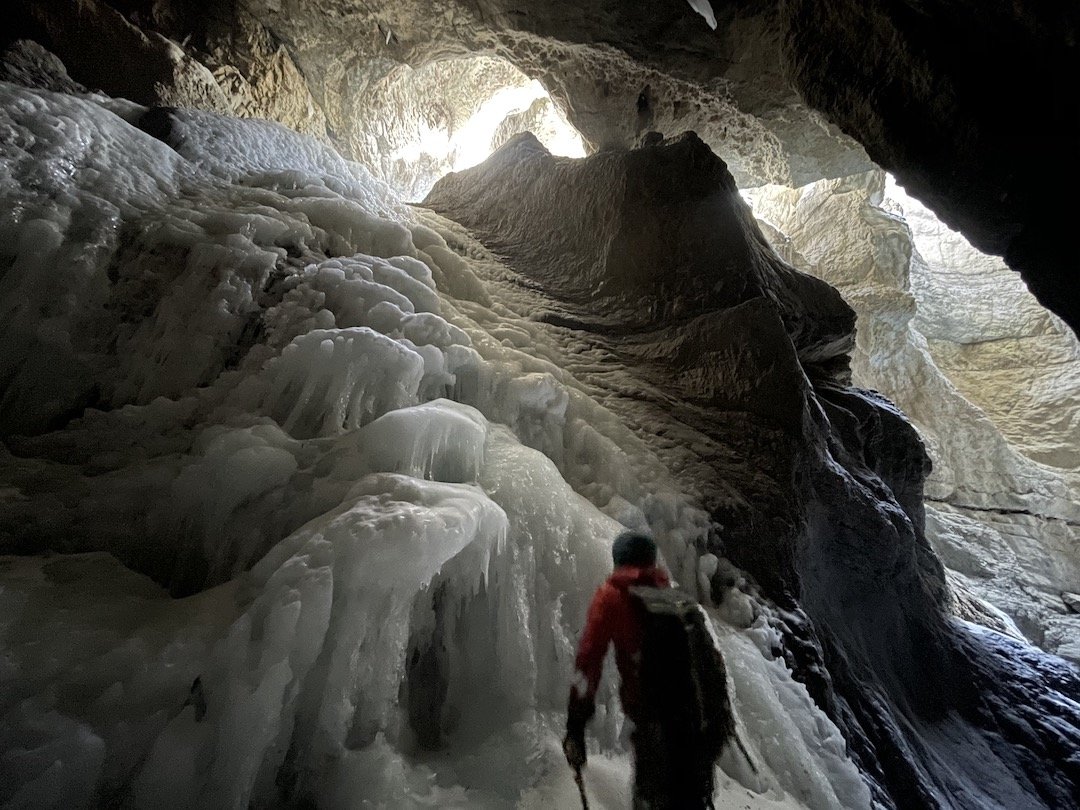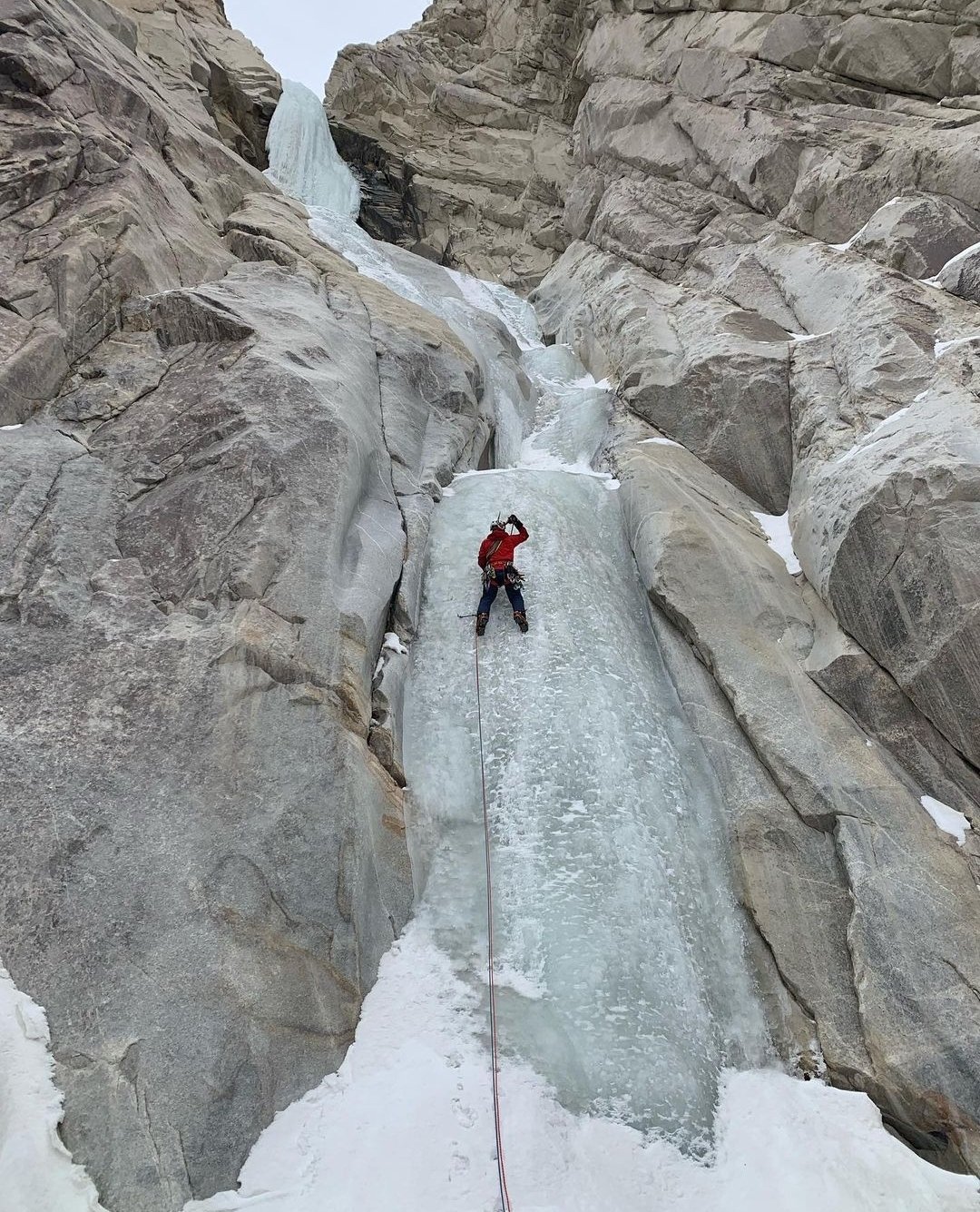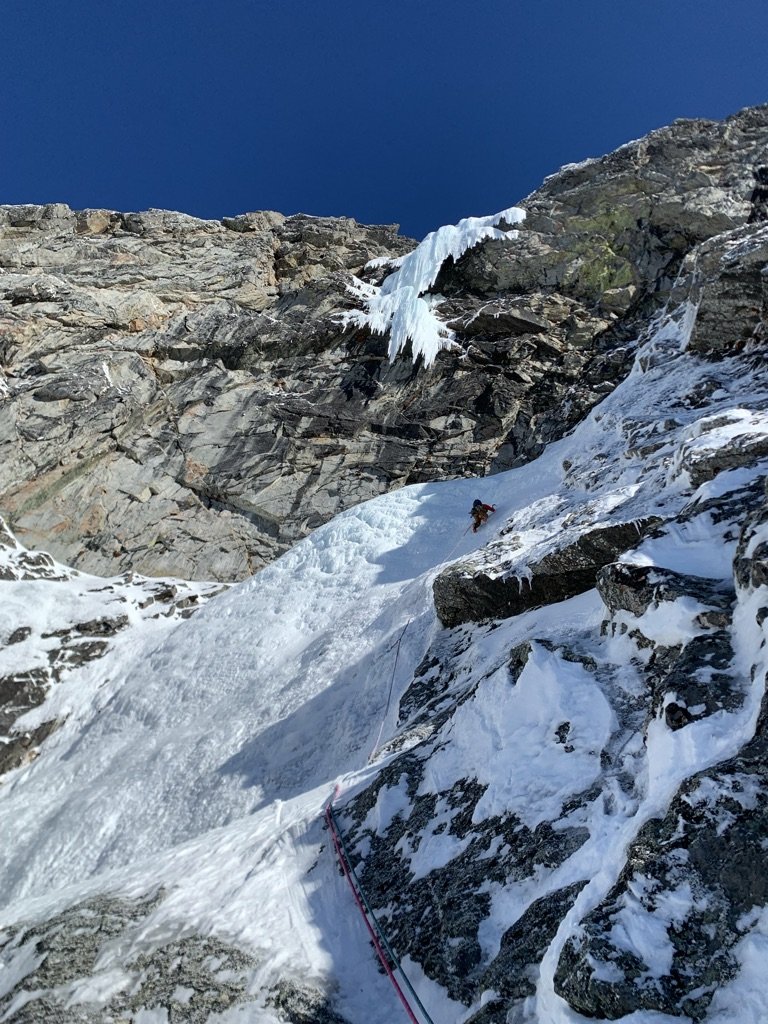Winter ice routes are already forming in many high places, and in case anyone needs inspiration to sharpen the tools, here are three fresh reports from the world of ice climbing. Each of these stories will appear in the 2024 AAJ—or follow the links below to read these reports online right now.
An easy but unforgettable ice pitch in the Grotto Creek canyon. Photo by Ethan Berkeland.
CHITISTONE MOUNTAIN, ALASKA
Hiking toward the final pitches of Hot French Grotto on the upper slopes of Chitistone Mountain. Photo by Ethan Berkeland.
In March 2023, four climbers discovered a long and very unusual ice route in the Chitistone Valley of Alaska’s Wrangell–St. Elias National Park. A steep 200-foot staircase of ice in the Grotto Creek drainage brought them into a canyon with 500-foot side walls and hidden ice pitches around every bend. “The ice burrowed into and out of the narrowing canyon walls,” Tristan O’Donoghue reports in his AAJ story, “making the whole scenario more reminiscent of navigating a slot canyon in the Utah desert than climbing an Alaskan peak.”
The climbers thought their route would end at the top of the canyon, but then they spotted more ice higher up. Another day’s exploration continued the line through the upper rock bands on the east side of Chitistone Mountain. All told, Hot French Grotto (IV WI4+) had about 1,400 feet and 12 pitches of technical climbing and 3,500 feet of total gain—a modern classic!
NUBRA VALLEY, INDIA
Javier Sánchez climbing the first pitch of Nubra-Spanish Chugyud, named after the Chugyud drainage in which it’s found. The steep ice to the right is unclimbed. Photo by Rafa Vadillo.
Rafa Vadillo on the first pitch of Changlung Right, a cascade-like ice formation typical of the Nubra Valley.
The AAJ reported on the first water ice climbs in Ladakh’s Nubra Valley in our 2021 edition. Inspired by that story, this past February, a group of Spanish climbers organized by Rafael Vadillo journeyed to the Nubra at the invitation of Rigzin Tsewang, a Ladkhi guide who is a driving force of the development of ice and rock climbing in the area. The Spanish climbers repeated most of the area’s established routes and put up several new climbs, including what might be the longest frozen waterfall yet climbed in India: The Masri Gyad, a 480-meter cascade that went at WI4+.
SLOAN PEAK, WASHINGTON
Last January, Tucker Merrill and Aaron Minton climbed a long new ice route on the west face of Sloan Peak, a well-known landmark to the west of Glacier Peak in the Cascades. The two found seven new pitches, with difficulties up to WI4+, to the left of Superalpine, a WI3/4 on the face that was established by Porter McMichael and Kyle McCrohen in 2020 and climbed to the summit by Fabien Legallo and Nick Roy in 2022. Merrill and Minton’s line eventually angled into Superalpine, which they followed for another three pitches before calling it a day at sunset; they rappelled and were back at their car after 22 hours on the move.
Above: Aaron Minton romps up easy ice and past an unclimbed hanger on the west face of Sloan Peak. Photo by Tucker Merrill. Below: The Merrill-Minton on the left and Superalpine on the right. Photo by John Scurlock.
The two dodged several harder pitches along their new route, and in the right conditions, it seems as though a Canadian Rockies–style line of drips might form down much of Sloan’s west face. Merrill noted in his AAJ story that these “steeper pitches appeared formidable, although a stronger party might be able to get the job done.”
ICE CLIMBING IN A CHANGING CLIMATE
Ice climbing is amazing—but the world’s ice climbing zones are changing fast. In a first-of-its-kind study that was a finalist for the International Climbing and Mountaineering Federation (UIAA) Mountain Protection Award, a team from the AAC joined up with climate researchers from the University of New Hampshire and the University of Calgary to take a close look at the data on seasonal temperatures and ice season length in the Mt. Washington Valley of New Hampshire, one of the premiere ice climbing destinations in the United States. The team ultimately created a climate model to predict the length of future ice climbing seasons under moderate and high emission scenarios. Learn about the AAC’s involvement in climate research and how it's impacting climbing by diving into this compelling new film about the project. Want more? The resources at this page on the AAC website go deeper.
IT’S TIME TO SUBMIT NEW AAJ REPORTS!
The long nights of winter are almost upon us—the perfect time to sit down at your keyboard and write a report for the 2024 AAJ. If you’ve done a long new route in the mountains or on a wall anywhere in the world, we want to hear about it. We also cover significant free ascents, link-ups, and mountain exploration. Write to us to learn how to submit a report.
Sign Up for AAC Emails
The Line is the newsletter of the American Alpine Journal (AAJ), emailed to more than 80,000 climbers each month. Find the archive of past editions here. Interested in supporting this online publication? Contact Billy Dixon for opportunities. Questions or suggestions? Email us: aaj@americanalpineclub.org.








